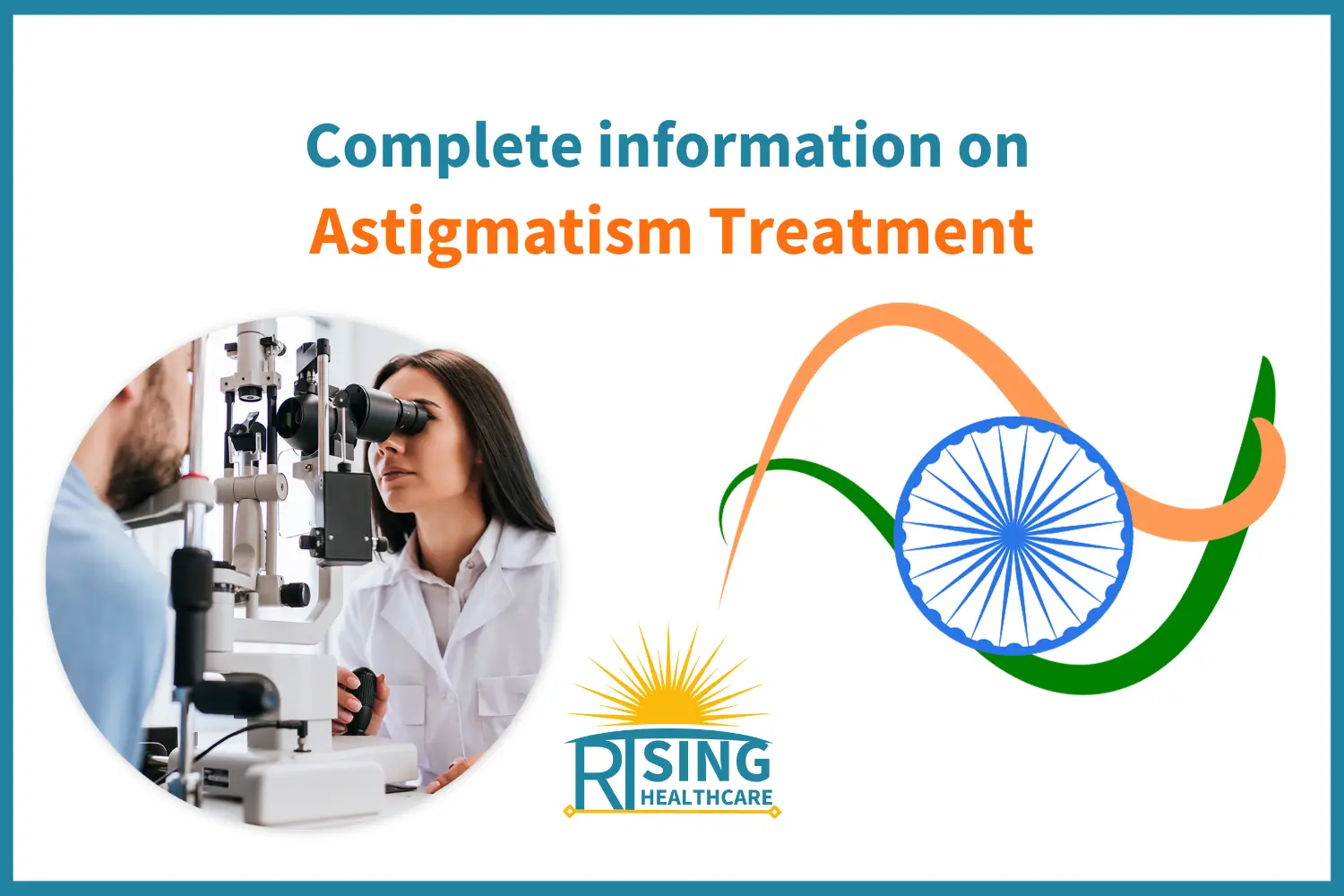
Everything You Need to Know About Knee Replacement Surgery
Introduction
Knee pain can be debilitating, affecting your mobility and quality of life. When conservative treatments fail to provide relief, knee replacement surgery becomes a viable option
Astigmatism Treatment: A Clearer Vision through Surgery
Introduction
Astigmatism is a common eye condition that affects millions of people worldwide. It can lead to blurred or distorted vision, making it difficult to see clearly. Fortunately, there are effective treatments available to correct astigmatism, with surgery being a popular option. In this comprehensive guide, we will explore astigmatism treatment, focusing on astigmatism surgery, specifically laser eye surgery for astigmatism. By the end of this article, you will have a better understanding of your treatment options and what to expect if you decide to undergo surgery to improve your vision.
. In this comprehensive guide, we will walk you through all aspects of knee replacement surgery, including what it is, its cost, and the different types available.
Contents
Understanding Astigmatism
Before delving into astigmatism treatment, let’s first understand what astigmatism is. Astigmatism is an eye condition that occurs when the cornea or lens of the eye has an irregular shape. Instead of being round and smooth like a basketball, the cornea or lens is shaped more like a football. This irregular shape causes light to enter the eye unevenly, resulting in distorted and blurred vision.
Common symptoms of astigmatism include:
- Blurred or fuzzy vision, both up close and at a distance.
- Eye strain and discomfort.
- Frequent headaches.
- Difficulty seeing at night.
- Squinting to try and see more clearly.
If you are experiencing any of these symptoms, it is essential to consult an eye care professional for a thorough eye examination. They will be able to diagnose astigmatism and recommend the most suitable treatment options based on the severity of your condition.
Astigmatism Treatment Options
Astigmatism treatment aims to correct the irregular shape of the cornea or lens to improve vision. There are several treatment options available, including eyeglasses, contact lenses, and surgery. Let’s take a closer look at each of these options.
- Eyeglasses: Eyeglasses are the most common and non-invasive way to correct astigmatism. An optometrist or ophthalmologist will prescribe glasses with specially designed lenses that compensate for the irregular shape of the eye. These lenses help to refract light properly onto the retina, providing clear vision.
- Contact Lenses: Contact lenses work similarly to eyeglasses but sit directly on the eye’s surface. They can be a good option for those who prefer not to wear glasses. There are toric contact lenses specially designed to correct astigmatism by aligning with the eye’s irregular shape.
- Astigmatism Surgery: For those seeking a more permanent solution, astigmatism surgery is an option. Two common surgical procedures for astigmatism correction are astigmatic keratotomy (AK) and laser eye surgery (LASIK or PRK). In this article, we will focus on laser eye surgery for astigmatism.
Laser Eye Surgery for Astigmatism
Laser eye surgery has revolutionized the field of vision correction and offers a highly effective solution for astigmatism. It is a popular choice for individuals looking to reduce their dependence on glasses or contact lenses. Let’s explore how laser eye surgery works and what you can expect from the procedure.
- Pre-Operative Evaluation: Before undergoing laser eye surgery, you will need to have a comprehensive eye examination to determine if you are a suitable candidate for the procedure. Your eye surgeon will assess your overall eye health, the degree of astigmatism, and other factors that may affect the outcome of the surgery.
- Consultation and Informed Consent: During this phase, you will have a consultation with your eye surgeon to discuss the procedure, its risks and benefits, and what to expect before, during, and after surgery. It’s essential to ask any questions you may have and ensure you fully understand the process before giving your informed consent to proceed.
- Surgery Day: On the day of the surgery, you will be asked to refrain from wearing contact lenses for a specified period before the procedure. This is to ensure the cornea returns to its natural shape, making it easier for the surgeon to reshape it accurately.
- Anesthesia: Laser eye surgery is typically performed with the help of local anesthesia in the form of eye drops. This numbs the eye, so you do not feel any pain during the procedure. You will remain awake throughout the surgery.
- Corneal Reshaping: The surgeon uses a specialized laser, such as an excimer laser, to reshape the cornea’s surface. This laser precisely removes tiny amounts of corneal tissue to correct the irregularities that cause astigmatism. The reshaping process is guided by a computerized mapping system that customizes the treatment to your specific eye.
- Recovery and Post-Operative Care: After the procedure, you will spend some time in the recovery area to ensure there are no immediate complications. Most patients can return home shortly after the surgery. However, it’s crucial to arrange for someone to drive you home, as your vision may be temporarily blurry.
- Follow-Up Appointments: Your eye surgeon will schedule several follow-up appointments to monitor your progress and ensure your eyes are healing correctly. It’s important to attend these appointments as directed to maximize the success of the surgery.
Advantages of Laser Eye Surgery for Astigmatism
Laser eye surgery for astigmatism offers several advantages:
- Improved Vision: The primary goal of the surgery is to significantly improve your vision, reducing or even eliminating the need for glasses or contact lenses.
- Quick and Painless: The procedure is relatively quick, typically taking only a few minutes per eye, and is virtually painless thanks to the local anesthesia.
- Rapid Recovery: Most patients experience a quick recovery, with improved vision within a few days to a week after the surgery.
- Long-Lasting Results: Laser eye surgery provides long-lasting results, and many people enjoy clear vision for years to come.
- Increased Convenience: Freedom from glasses or contacts can be liberating, especially for those with active lifestyles or professions where clear vision is essential.
Is Laser Eye Surgery for Astigmatism Right for You?
While laser eye surgery for astigmatism is a highly effective and popular treatment option, it may not be suitable for everyone. The following factors may influence your candidacy for the procedure:
- Age: You should be at least 18 years old for most laser eye surgeries.
- Stable Prescription: Your prescription for glasses or contact lenses should have remained stable for at least a year.
- Good General Health: You should be in good overall health, with no underlying medical conditions that may affect the healing process.
- Realistic Expectations: It’s essential to have realistic expectations about the outcome of the surgery. While laser eye surgery can significantly improve your vision, it may not achieve perfect vision in all cases.
- No Contraindications: Certain eye conditions or medical factors may make you ineligible for laser eye surgery. Your eye surgeon will assess your specific situation during the pre-operative evaluation.
Potential Risks and Complications
Like any surgical procedure, laser eye surgery for astigmatism carries some risks and potential complications. It’s crucial to be aware of these before making your decision. Common risks include:
- Dry Eyes: Some people may experience temporary or even long-term dryness of the eyes after surgery. This can usually be managed with eye drops.
- Glare and Halos: Some patients may notice glare, halos, or starbursts around lights, particularly at night, following surgery. These symptoms often improve over time.
- Undercorrection or Overcorrection: In some cases, the surgery may not fully correct astigmatism, or it may overcorrect it, necessitating additional procedures or the continued use of glasses or contact lenses.
- Infection: Although rare, there is a risk of infection following surgery. Proper post-operative care and hygiene can minimize this risk.
- Regression: In some cases, the eye may gradually revert to its previous prescription over time. Enhancements or retreatments may be necessary to maintain clear vision.
Conclusion
Laser eye surgery for astigmatism is a highly effective and popular treatment option for those looking to improve their vision. It offers the potential for clear vision without the need for glasses or contact lenses, providing increased convenience and freedom. However, it’s essential to consult with an experienced eye surgeon to determine if you are a suitable candidate for the procedure and to fully understand the potential risks and benefits.
If you decide that laser eye surgery is right for you, make sure to choose a reputable eye surgeon and follow their pre-operative and post-operative instructions diligently. With the right care and guidance, you can look forward to a clearer and more vibrant world with improved vision. Remember that your eye health is precious, and it’s worth taking the time to explore all your treatment options to ensure the best possible outcome.

